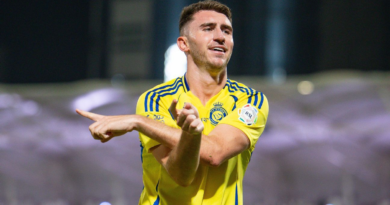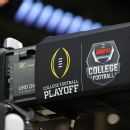What Cameron Brink's injury means for Sparks and Team USA's 3×3
The worst fears about Los Angeles Sparks rookie forward Cameron Brink‘s knee injury were confirmed Wednesday: She suffered a torn ACL in her left knee and will miss the rest of the 2024 WNBA season and the Paris Olympics.
It’s a crushing blow for Brink, the Sparks, the WNBA and USA Basketball, which must replace her on the 3×3 roster. Brink was injured in the opening minutes of the Sparks’ loss Tuesday at the Connecticut Sun. The No. 2 pick in April’s WNBA draft, she was off to a solid career launch with the Sparks, starting all 15 games.
Now Los Angeles — which hasn’t made the playoffs since 2020 and is in what might be called a franchise refresh with longtime star Nneka Ogwumike now with the Seattle Storm — must move on without Brink. And Brink must deal with the dual disappointments of missing out on a trip to the Olympics and not being able to complete the rest of her rookie season.
The New York Liberty dealt with a similar issue in 2020 when No. 1 pick Sabrina Ionsecu suffered a season-ending ankle injury three games into her rookie season. Ionescu recovered well: She returned in 2021, was an All-Star and second-team WNBA pick last season and is part of the U.S. 5-on-5 Olympic team this year.
The outlook is still bright for Brink, although that doesn’t provide much solace for her or the 4-11 Sparks right now. Here’s a look at how Brink has played thus far, where the Sparks go from here this season and what Brink’s future might hold.
How had Brink performed up to this point of her rookie season?
Pelton: As expected, Brink had been one of the WNBA’s top rookies, rating as a league-average player right away. I have her third among the four players from this year’s draft who have performed better than replacement level in at least 100 minutes of action:
In particular, Brink has excelled defensively, blocking a league-high 9% of opponent 2-point attempts. Among players who have defended at least 40 shot attempts in the paint according to Second Spectrum tracking, Brink ranks fifth with opponents hitting just 51% of those shots.
Foul trouble was predictably an issue for Brink, who was averaging 6.5 fouls per 36 minutes, but the Sparks can feel good about how well she played before the injury.
Voepel: Brink needed just a few pro games to show she was on her way to being one of the elite shot blockers in the WNBA. Her early comps in blocks were to players like Margo Dydek, Lisa Leslie and Brittney Griner. From timing, anticipation and coordination standpoints, Brink clearly has what it takes to be a rim protector. That’s a tough thing for the Sparks to lose right now.
How do the Sparks adjust to her absence? How does the lineup change? Which non-rostered player might Los Angeles sign?
Pelton: The silver lining for the Sparks is backup center Li Yueru has been coming on lately during her first extended WNBA action after playing just 82 minutes as a rookie with the Chicago Sky in 2022. Li had a career-high 18 points at Seattle earlier this month, finishing the game over Brink, and 11 points on 5-of-6 shooting in the game when Brink was injured. Per 36 minutes, her averages of 14.2 points and 10.6 rebounds are better than Brink (12.3 and 8.7), although Li is nowhere near the kind of deterrent around the rim as a shot blocker.
Down the road, Los Angeles could get Azura Stevens back in the lineup before long. When Stevens initially suffered a left arm injury playing in China and underwent surgery, the Sparks indicated she’d be reevaluated in 12 weeks. We’ll hit that mark on Friday. Stevens can play either center alongside Dearica Hamby or power forward next to Li.
If Stevens is still expected to miss at least another three weeks, Los Angeles would be eligible for a hardship exception to add a 13th player to the roster. Queen Egbo, recently waived by Connecticut, would be a logical target. Alternatively, the Sparks could bring back Hungarian center Virag Kiss, who was with the team in training camp.
Voepel: Roster decisions are always difficult, and it raised some eyebrows when the Sparks waived Monique Billings before the season. The 6-foot-4 Billings, who played six seasons with the Atlanta Dream, is a veteran post presence not easy to find. It was good fortune for the Dallas Wings, who signed Billings four days after the Sparks let her go. She is averaging career highs of 11.9 points and 8.8 rebounds now for the Wings.
It’s water under the bridge for the Sparks. It’s too early to write off the postseason, but realistically everything just got even tougher for Los Angeles. As Kevin said, Li is promising — she’s just 25 and is coming off playing a season-high 26 minutes on Tuesday. And Stevens can make a noticeable impact whenever she returns.
A lot of focus now will go on forward Rickea Jackson, the Sparks’ other 2024 draft lottery pick this season. The No. 4 selection, she is averaging 10.3 points and 3.6 rebounds. Jackson’s best game so far was a 19-point, 10-rebound performance vs. the Minnesota Lynx on June 14. Jackson has scored in double figures in four of her last five games, shooting 56.1% from the field in that span. She’s a talented scorer who is also capable of being a versatile defender for the Sparks.
What changes does USA Basketball make to its 3×3 roster?
Pelton: Based on FIBA’s 3×3 rules, USA Basketball must replace Brink with another player who has sufficient qualifying points in 3×3 competitions, meaning the USA can’t simply pick Aliyah Boston after she was left out of the Olympic roster for the traditional 5-on-5 team.
Additionally, USA Basketball will probably want to fill Brink’s spot with another post to complement guard Hailey Van Lith, wing Rhyne Howard and fellow post Cierra Burdick. Looking through the FIBA individual rankings, the most logical replacement is Hamby, who automatically qualifies by ranking among the top 20 U.S. players in 3×3 points.
Hamby is having an All-Star season in the WNBA — she was among the picks by ESPN’s Alexa Philppou for the roster that will take on the USA’s 5-on-5 Olympic team in this year’s WNBA All-Star Game — and brings more 3×3 experience than other players of that ilk.
If USA Basketball is less concerned about replacing Brink’s size, Howard’s Atlanta Dream teammate Allisha Gray would be another strong candidate after helping the USA win the inaugural 3×3 gold in 2021 in Tokyo. Or the USA could bring back Katie Lou Samuelson of the Indiana Fever, who was set to be part of the team three years ago before contracting COVID-19 and missing out.
Voepel: Agree with Kevin: Hamby, Samuelson or Gray appear to be the best picks to replace Brink, who has put in a lot of time with 3×3. It’s heartbreaking she will miss the Olympics, something Samuelson understands all too well.
Last year, Brink was MVP of the FIBA 3×3 Women’s World Cup in Vienna, Austria, as the United States won gold. She also competed in two 2023 FIBA 3×3 Women’s Series stops as the Americans were second in both Montreal and Quebec.
The 3×3 tournament proved really popular among U.S. viewers in 2021, when Gray, Kelsey Plum, Jackie Young and Stefanie Dolson won gold. Young and Plum are now on the 5-on-5 team for Paris, which might be in Brink’s future.
What does Brink’s future with the Sparks and USA Basketball look like?
Voepel: As difficult as ACL injuries and rehab are, it’s something countless players have come back from to have outstanding careers. Brink will have time to recover and hopefully return for the 2025 WNBA season. And she could be part of the 5-on-5 or 3×3 team in the 2028 Los Angeles Games.
Pelton: Brink remains a building block for the Sparks, along with Jackson and whoever Los Angeles drafts next year — likely in the lottery. The hope is this injury happening relatively early in the season allows Brink to get back on the court in time for 2025 training camp. Consider that almost exactly a year ago (June 20), Connecticut center Brionna Jones suffered a similar season-ending injury, an Achilles rupture. Now Jones has played all 14 games at her usual All-Star level and helped the Sun to the best start in franchise history.





